LCMS sample prep
Name
Published by
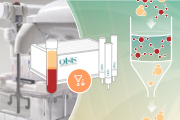
This basic method provides the core methodology for translating a workflow into OneLab-executable script(s) as an attempt to fully or semi-automate a specific procedure. It demonstrates the benefits of automation and highlights OneLab capabilities and best practices to promote solution adoption, helping transition from manual to a more automated approach. It can be used alone or serves as a building block for a more complex workflow and is easily adaptable to users' requirements.
The following work demonstrates the capabilities of the Andrew+ Pipetting Robot in combination with the Extraction+ Connected Device for fully automated bioanalytical solid phase extraction (SPE) for a variety of pharmaceutical drugs from plasma.
Protocols for both cartridge and 96-well SPE plate formats are included. Calibration curves and QC samples are created in one protocol and extracted in a separate one.
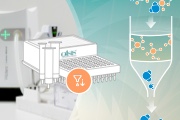
This basic method provides the core methodology for translating a workflow into OneLab-executable script(s) as an attempt to fully or semi-automate a specific procedure. It demonstrates the benefits of automation and highlights OneLab capabilities and best practices to promote solution adoption, helping transition from manual to a more automated approach. It can be used alone or serves as a building block for a more complex workflow and is easily adaptable to users' requirements.
This work demonstrates the capabilities of the Andrew+ Pipetting Robot configured with the Extraction+ Connected Device for fully automated SPE sample preparation using cartridge and plate formats.
Described Protocols use a simple 3-step SPE procedure (load, wash, and elution) in combination with Waters reversed-phase Oasis HLB cartridges (1, 3, and 6 cc size) and 96-well macro and μElution plates.
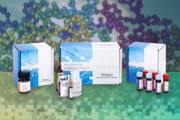
This basic method provides the core methodology for translating a workflow into OneLab-executable script(s) as an attempt to fully or semi-automate a specific procedure. It demonstrates the benefits of automation and highlights OneLab capabilities and best practices to promote solution adoption, helping transition from manual to a more automated approach. It can be used alone or serves as a building block for a more complex workflow and is easily adaptable to users' requirements.
Bottom-up proteomics is a useful approach for the discovery of signature peptides to identify specific proteins found in the complex food matrix.
Here we present a fully automated sample preparation protocol for protein digestion using the ProteinWorks kit, and the final mixture obtained will be ready for a typical LCMS method.
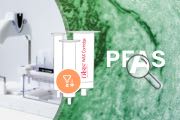
Automation of PFAS Extraction in Firefighting Foam using SPE with Oasis WAX/GCB cartridges
Waters Corporation
This basic method provides the core methodology for translating a workflow into OneLab-executable script(s) as an attempt to fully or semi-automate a specific procedure. It demonstrates the benefits of automation and highlights OneLab capabilities and best practices to promote solution adoption, helping transition from manual to a more automated approach. It can be used alone or serves as a building block for a more complex workflow and is easily adaptable to users' requirements.
A major component of many Class B firefighting fluids (FFF) is PFAS, particularly aqueous film forming foams (AFFF). However, the concentration of PFAS in AFFF is extremely high. Preparing FFF samples for LC-MS/MS analysis involves many labor-intensive pipetting steps. An automated workflow is described in this protocol to improve laboratory efficiency and reduce human error using Andrew+ and Extraction+, along with Oasis WAX/GCB cartridges, which maximizes PFAS recovery while reducing matrix interferences for LC-MS/MS analysis.
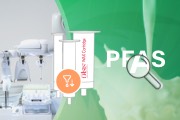
This basic method provides the core methodology for translating a workflow into OneLab-executable script(s) as an attempt to fully or semi-automate a specific procedure. It demonstrates the benefits of automation and highlights OneLab capabilities and best practices to promote solution adoption, helping transition from manual to a more automated approach. It can be used alone or serves as a building block for a more complex workflow and is easily adaptable to users' requirements.
The European Food Safety Authority (EFSA) predicts that PFAS exposure is primarily through food. Milk, being the staple food product for toddlers and children, would affect them disproportionately compared to adults, so there is a need to monitor PFAS levels in milk.
In addition to using Andrew+ and Extraction+ for improved throughput and reduced errors, this method uses Oasis WAX SPE cartridges to enhance PFAS recovery and reduce matrix interferences for LC-MS/MS analysis. Automation also allowed for washing the walls of the sample vials with eluent, increasing the recovery of PFAS.
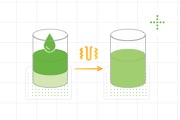
This basic method provides the core methodology for translating a workflow into OneLab-executable script(s) as an attempt to fully or semi-automate a specific procedure. It demonstrates the benefits of automation and highlights OneLab capabilities and best practices to promote solution adoption, helping transition from manual to a more automated approach. It can be used alone or serves as a building block for a more complex workflow and is easily adaptable to users' requirements.
Dilute-and-shoot is a simple and rapid analytical method for multi-analyte identification. Although sample preparation is minimal, it remains a critical step to ensure accurate quantitation.
The protocols described here use the dilute-and-shoot approach and take advantage of the Andrew+ capabilities to automate sample preparation ensuring maximum pipetting precision and efficient mixing.
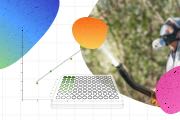
This basic method provides the core methodology for translating a workflow into OneLab-executable script(s) as an attempt to fully or semi-automate a specific procedure. It demonstrates the benefits of automation and highlights OneLab capabilities and best practices to promote solution adoption, helping transition from manual to a more automated approach. It can be used alone or serves as a building block for a more complex workflow and is easily adaptable to users' requirements.
Pesticide analysis is critical to ensure agricultural commodities comply with legal limits. Matrix effects are a common concern, as they can compromise detection and quantification quality.
Here, we present a fully automated protocol for matrix-matched standard curve preparation ready for a typical LC-MS/MS method.
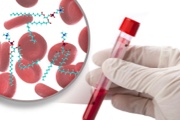
This basic method provides the core methodology for translating a workflow into OneLab-executable script(s) as an attempt to fully or semi-automate a specific procedure. It demonstrates the benefits of automation and highlights OneLab capabilities and best practices to promote solution adoption, helping transition from manual to a more automated approach. It can be used alone or serves as a building block for a more complex workflow and is easily adaptable to users' requirements.
Lipids are important molecules involved in energy metabolism, signaling, and membrane formation. They are pivotal in understanding disease and its progression.
Here we highlight an automated MTBE liquid-liquid extraction method of lipids and small molecules from biological matrices. The automated method helps streamline this multi-step extraction protocol saving time and reducing operator errors.
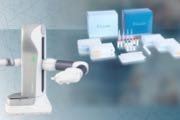
This advanced method offers an end-to-end solution developed around an advanced application, a specialized kit, or an analytical system. It delivers complete functional, ready-to-use protocols that are qualitatively and quantitatively assessed for consistency, executability, and repeatability, usually without needing to make any changes. It operates per batch size and is scalable to accommodate changing requirements.
The MxP® Quant 500 is a comprehensive, ready-to-use kit crafted for precise quantitative metabolic profiling and rigorously quality-controlled to ensure optimal performance.
Leveraging the Andrew+ pipetting system and the corresponding OneLab protocol enhances throughput, reduces personnel involvement, and increases reproducibility, making it ideally suited for extensive large-scale studies.
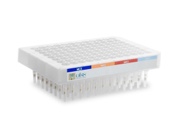
This basic method provides the core methodology for translating a workflow into OneLab-executable script(s) as an attempt to fully or semi-automate a specific procedure. It demonstrates the benefits of automation and highlights OneLab capabilities and best practices to promote solution adoption, helping transition from manual to a more automated approach. It can be used alone or serves as a building block for a more complex workflow and is easily adaptable to users' requirements.
Mixed-mode SPE is a sample clean-up technique for LC-MS analysis. Selecting a mixed-mode SPE sorbent can be challenging, requiring a good understanding of the sorbent/analyte chemistry. In addition, it involves accurate and precise pipetting steps.
This protocol demonstrates a rapid and robust Andrew+ automated mixed-mode SPE sorbent selection method using the Oasis 2x4 sorbent selection plate.
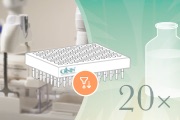
This advanced method offers an end-to-end solution developed around an advanced application, a specialized kit, or an analytical system. It delivers complete functional, ready-to-use protocols that are qualitatively and quantitatively assessed for consistency, executability, and repeatability, usually without needing to make any changes. It operates per batch size and is scalable to accommodate changing requirements.
Solid phase extraction (SPE) is a routinely used sample preparation technique in bioanalytical/DMPK laboratories, selectively capturing the analyte or drug target while removing biomatrix components, thus improving the sensitivity, selectivity, and robustness of the analytical method. SPE is often perceived as complex and labor-intensive, requiring lengthy method optimization to achieve high analyte recovery.
The 20 bottle method optimization approach described in the Oasis HLB care & use manual provides an elegant way of optimizing the organic composition of the wash and elution solvents in a single experiment, significantly simplifying the method development process.
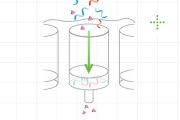
This basic method provides the core methodology for translating a workflow into OneLab-executable script(s) as an attempt to fully or semi-automate a specific procedure. It demonstrates the benefits of automation and highlights OneLab capabilities and best practices to promote solution adoption, helping transition from manual to a more automated approach. It can be used alone or serves as a building block for a more complex workflow and is easily adaptable to users' requirements.
Protein precipitation is the simplest form of plasma/serum preparation. However, pipetting errors and contamination during sample preparation can impair assay sensitivity, robustness, and precision.
In the following work, Andrew+ was used to prepare and extract analytes from complex biological matrices, using the Ostro sample prep plate, with subsequent LC-MS/MS analysis and quantification.
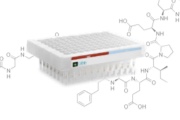
This basic method provides the core methodology for translating a workflow into OneLab-executable script(s) as an attempt to fully or semi-automate a specific procedure. It demonstrates the benefits of automation and highlights OneLab capabilities and best practices to promote solution adoption, helping transition from manual to a more automated approach. It can be used alone or serves as a building block for a more complex workflow and is easily adaptable to users' requirements.
Therapeutic and endogenous peptides can be difficult to extract using SPE with high reproducibility. This is often due to user errors encountered during the extraction process.
Here we present an extraction protocol for peptides using the Andrew+ robot which demonstrates rapid and robust automated mixed-mode SPE sorbent selection using the Oasis Peptide Method Development 96 well μElution Plate.

This basic method provides the core methodology for translating a workflow into OneLab-executable script(s) as an attempt to fully or semi-automate a specific procedure. It demonstrates the benefits of automation and highlights OneLab capabilities and best practices to promote solution adoption, helping transition from manual to a more automated approach. It can be used alone or serves as a building block for a more complex workflow and is easily adaptable to users' requirements.
Waters RapiZyme MC1 and RapiZyme Cusativin provide controlled and reproducible RNA (e.g. sgRNA, mRNA, etc) digestion with targeted digestion.
The unique cleavage patterns produced by these endoribonucleases generate a myriad of medium length RNA digestion products for LC-MS oligonucleotide mapping with improved sequence coverage.
